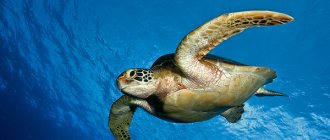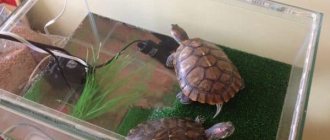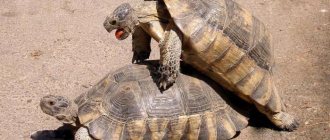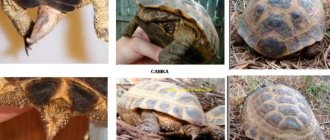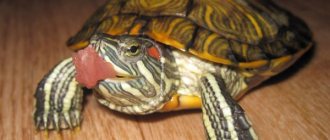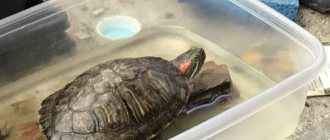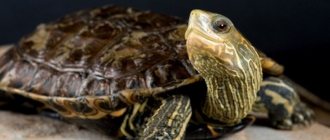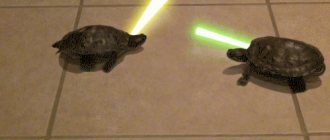The turtle is one of the oldest animals that belongs to the order of reptiles. The turtle's body is covered on all sides with a shell, which provides protection from external damage and attacks from predatory animals. The habitat of these animals is quite diverse. They can live both in aquatic environments and on land.
Turtles are dioecious creatures. But they do not have pronounced external sexual characteristics. The turtle's reproductive organ is hidden under its shell. But still, there are some differences between individuals of different sexes. Let's figure out how to correctly determine the sex of a turtle.
Reproduction of land turtles in captivity. Under what conditions can offspring be obtained?
Many owners of land turtles wonder: can their pets reproduce in captivity?
Until relatively recently, obtaining offspring from these exotic animals was considered almost a feat. Very little was known about the care of small turtles. Even those owners whose pets had offspring experienced significant difficulties in preserving and further raising young animals. Fortunately, the situation has now changed, and various species of turtles often breed at home. But only if certain rules are followed can one achieve sustainable success in this rather difficult matter.
Reproductive system in turtles
Owners whose favorite pets are turtles are interested in the issue of reproduction in captivity, which is associated with the structure of the genital organs and “mating” behavior. The unusual configuration of the body of the animal itself implies that the reproductive system is also arranged in a unique way. Like other reptiles, turtles lay eggs, but internal fertilization occurs before that.
A few important points to consider before breeding
To give baby turtles the best start in life, it is important that they are conceived by healthy parents. Turtles that show signs of illness or stress should not be bred from
You also cannot take animals that you have recently cured. If a male turtle is producing healthy, motile sperm capable of fertilizing eggs, he needs to receive just as much attention as a female turtle. This factor is often overlooked by new breeders. Sexual maturity in land turtles occurs at approximately 10-15 years for females, and at 5-6 years for males. Until this point, they should not be mated. A male can be defined as follows: in the shell of male individuals there is a special hole so that he can mate with females. The tail is longer mainly in males, and the anus is located at the tip of the tail. You can determine readiness for mating by the behavior of your pets. The breeding season for turtles in the wild coincides with spring. Turtles' activity increases sharply: males begin to fight for the attention of females and make certain sounds similar to barking. If fertilization has occurred, the behavior of the female will indicate this. After two months after mating, the females begin to lay eggs. To do this, the expectant mother digs a hole and sprays it with the contents of her urinary and two anal bladders. After this, she needs to bury the hole and compact the earth. To do this, the female stands on her feet and then sharply leans her shell against the ground. The female is able to store sperm for several years!
Top 10: Strange genitalia of the animal world
People have made genitals such a taboo subject that even mentioning them would make someone blush. However, animals are friendly with their genitals - and develop them in different directions. Size is not very important for them, but explosions, spikes and hypodermic injections are the opposite.
10. Sea Slug Hypodermic Penis
The colorful sea slug Siphopteron quadrispinosum has a penis that works much like a hypodermic syringe. The appendage, equipped with several large hooks at the base and a pair of needles at the tip, allows it to firmly attach to a female (female is a big word - sea slugs are actually hermaphrodites) and pierce her, injecting prostate juice. Having such a horribly decorated penis is of course harmful to their mates, but researchers believe that aggressive mating actually increases the chance of reproduction and fertility. Photo by Ayami Sekizawa
9. Double shark penises
Apparently, one penis is not enough for sharks. They definitely need two penises at once. Each organ is actually coiled cartilage that tenses when excited. So it's a functional penis, but with a twist. Once the penis is inserted into the partner, it opens like an umbrella in order to tie the sharks together. Oh, did we mention that the penis also has spurs? Apparently sharks like it rough.
Despite the fact that sharks have two penises, they only use one at a time, which is why scientists think that the second one may serve as a spare one in case of “malfunctions”. Most guys who used to get drunk now think a spare penis is a good idea.
8. Turtles have truly huge penises.
Sea and land turtles are “rich” where they need to be. When erect, a turtle's penis can increase by 50% in length, 75% in girth and 10% in depth. In most turtles, the fully erect organ reaches or even exceeds half the length of their body. So, when you see a two-meter turtle, remember that its penis can reach one and a half meters. It is believed that turtles carry such a “sword” both for sexual purposes and for protection and intimidation. In this case, it worked - just the thought of it is already scary.
7. Polar bears' genitalia are shrinking
Increasing pollution in the Arctic is taking its toll on polar bears, who are feeling the effects of pollution in places few would like. Polar bears already reproduce very poorly - they have a very low libido, and it takes many years to reach sexual maturity. The problem of mysteriously shrinking genitals is likely to make matters worse, and scientists fear polar bears will lose their desire to reproduce entirely.
6. Four-headed echidna penis
Echidnas, like platypuses, are members of the order Monotreme, which means they are egg-laying mammals. As if that weren't enough to call them weird, they also have four penis heads. This is confusing to biologists, since female echidnas only have two vaginal openings (in total, hehe), but some believe that the echidna's amazing organ is a "double shotgun" evolved to increase the chances of successful fertilization through a simple increase in volume.
5. Paddlers' penises can reach 100 decibels
Grebes, small two-millimeter aquatic insects, can sing using their penises. How? They use a process called stridulation, which involves rubbing two textured surfaces to create sound. Crickets do this with their legs, but paddlers prefer to use other parts of their body.
Their penis sounds, by the way, reach 100 decibels. It's the equivalent of sitting front row at an orchestral concert and they do it with their penis. Their chants can be heard by passersby outside the water, and the sounds underwater are as loud as a passing freight train.
Laboratory diagnosis of turtle diseases
In a clinical laboratory, the following minimum laboratory tests can be performed:
- urine test,
- feces,
- clinical and biochemical blood tests.
Testing urine and feces in turtles
Urine may be obtained
- by squeezing the bladder (the thumb and index finger are inserted into the fossa between the carapace and plaston at the base of the thighs),
- by inserting a catheter into the bladder,
- by cystocentesis (in extreme cases).
Many turtles empty their bladder reflexively during examination and painful manipulation, so during examination you need to provide a clean tray to collect the urine.
When examining urine, indicators such as
- density,
- acidity,
- protein,
- glucose,
- blood,
- presence and color of urinary sediment.
It is necessary to perform microscopy of native and stained smears.
By analyzing the urine of a sick turtle, kidney and liver disorders, dehydration status, urolithiasis, neoplasms of the cloaca and bladder, the presence of flagellated parasites, etc. can be presumably established. The presence of live sperm in the urine is one of the ways to determine sex in reptiles.
When examining stool, you need to pay attention to
- color,
- consistency,
- smell,
- presence of foreign bodies.
When examining fecal matter, it is also necessary to conduct microscopy of native and stained smears, and examination of material enriched by flotation methods.
Using stool analysis, it is possible to presumably determine dysbacteriosis, some bacterial diseases, liver failure, and diagnose protozoa and helminthiases.
Biochemical and clinical blood tests
The total blood volume in reptiles is approximately 5-8% of body weight. In turtles it is relatively lower, since the proportion of bone tissue in the total body mass is high. Without harm to the animal, blood can be taken in a volume of 1% of body weight. Taking blood from turtles for biochemical and clinical research is best done from the right jugular vein (the left one is reduced) (Fig. 1).
When cutting off a claw, the tip of a tail, or puncture of venous sinuses, the sample becomes contaminated with lymph and tissue fluid, which in turn leads to a false increase in some indicators. It is best to use lithium heparin as an anticoagulant, because other anticoagulants cause hemolysis and change such indicators as total blood calcium.
Immediately after collection, part of the blood should be used to prepare a thin smear, the rest of the blood should be centrifuged as quickly as possible. Since the norms published by different authors may differ significantly from each other, the laboratory must have at its disposal the results of studies obtained from clinically healthy animals of a given species to characterize its “norms”, and it is necessary to use the same techniques, in addition, normal indicators may vary depending on age, gender, season, living conditions, feeding, etc.
In our opinion, biochemical analysis should include such indicators as
- calcium,
- phosphorus,
- sodium,
- potassium,
- uric acid,
- creatinine,
- urea,
- total protein,
- alanine aminotransferase,
- asaparataminotransferase,
- alkaline phosphatase.
The biochemical profile in turtles is interpreted in the same way as in other animals.
In a clinical blood test of turtles, indicators such as
- hemoglobin,
- total number of red blood cells and white blood cells,
- hematocrit,
- counting the leukocyte formula (heterophils, eosinophils, basophils, lymphocytes, monocytes).
Performing and interpreting a clinical blood test is a rather complex task that requires special techniques and experience.
Features of behavior
It is especially possible to determine the sex of red-eared turtles during the mating season. Behavioral characteristics indicate that each pet belongs to one gender or the other. During the mating season, the activity of males increases sharply. They organize all sorts of demonstrations to demonstrate their capabilities. At the same time, they actively swing their front legs, with much larger claws than the females have. During this period, they constantly chase females and make attractive head movements.
If someone is seriously involved in breeding red-eared turtles, then this article will be very useful, since at an early stage, before they are ready to reproduce, turtle pairs can be formed. In addition, such knowledge will help to correctly and accurately name pets, which is very important for many owners.
In pursuit of something unusual, it has recently become fashionable to keep exotic animals such as snakes, boa constrictors, chameleons, etc. at home. This list also includes many species of turtles, including the red-eared slider. All of them are representatives of the tropics and require special attention and special conditions of detention. It is very important that all those who want to have a red-eared turtle at home understand that it also needs certain conditions, without which it simply cannot live. In addition, this is a very expensive business, since the turtle’s diet must be varied, otherwise it will not be able to develop normally due to lack of nutrients.
The hypothalamus is the most important organ of internal secretion
The hypothalamus is a part of the diencephalon. Together with the pituitary gland, the hypothalamus forms the hypothalamic-pituitary system, in which the hypothalamus controls the release of pituitary hormones and is the central link between the nervous system and the endocrine system. The hypothalamic-pituitary system includes neurosecretory cells that have the ability to be neurosecretory, that is, they produce neurohormones. These hormones are transported from the neurosecretory cell bodies located in the hypothalamus along the axons that make up the hypothalamic-pituitary tract to the posterior part of the pituitary gland (neurohypophysis). From here these hormones enter the blood. In addition to large neurosecretory cells, the hypothalamus contains small nerve cells. Nerve and neurosecretory cells of the hypothalamus are located in the form of nuclei, the number of which exceeds 30 pairs. The hypothalamus is divided into anterior, middle and posterior sections. The anterior part of the hypothalamus contains nuclei, the neurosecretory cells of which produce neurohormones - vasopressin (antidiuretic hormone) and oxytocin.
Antidiuretic hormone promotes increased reabsorption of water in the distal tubules of the kidneys, and therefore urine output decreases and it becomes more concentrated. When the concentration in the blood increases, antidiuretic hormone constricts the arterioles, which leads to an increase in blood pressure. Oxytocin selectively acts on the smooth muscles of the uterus, increasing its contraction. During childbirth, oxytocin stimulates uterine contractions, ensuring their normal course. It can stimulate the release of milk from the alveoli of the mammary gland after childbirth. The middle section of the hypothalamus contains a number of nuclei consisting of small neurosecretory cells that produce releasing hormones, or stimulate or suppress the synthesis and secretion of hormones of the adenohypophysis. Neurohormones that stimulate the release of pituitary tropic hormones are called liberins. For neurohormones – inhibitors of the release of pituitary hormones, the term “statins” has been proposed. In addition to releasing hormones, the hypothalamus synthesizes peptides that have a morphine-like effect. These are enkephalins and endorphins (endogenous opiates). They play an important role in the mechanisms of pain and analgesia, regulation of behavior and autonomic integrative processes.
How can behavior help determine the sex of a turtle?
- Red-eared females, like any female representatives, are calmer. Males are active and, to some extent, even aggressive. This behavior especially intensifies when they attract the attention of girls. They can often bite them on the neck, nod their heads, actively wave or claw at them.
- Males are also capable of making sounds that resemble a squeak. But some subspecies of females can also imitate such a whistle. Therefore, this is not the most pronounced indicator.
The most reliable determination of the sex of turtles is made by blood tests for hormones, x-rays and ultrasound. But it is not always possible to conduct such studies. Moreover, due to the peculiarities of the hormonal system of reptiles and their anatomical structure, this should be done not by an ordinary “human” doctor with access to equipment, but by a biologist.
Important: Therefore, we conclude that determining sex by external characteristics in young reptiles cannot be considered reliable. And it is based more on assumptions than on specific indicators. It is possible to determine the sex of a turtle only when it reaches sexual maturity, taking into account all the above features.
Wait until maturity to check.
If you are unable to determine the sex of a young turtle, follow simple advice - purchase any reptile. And only when she reaches sexual maturity, and you determine her gender, will she be able to purchase an adult turtle of the opposite sex as a mate. There are no significant differences in content between males and females.
Turtle Reproduction: Compatible Pairs
The first thing to remember is that only turtles of the same species can interbreed. In many cases, unlucky breeders simply cannot find compatible pairs. Let us repeat, different species should never be crossed. But following this rule is not enough for complete success: many more factors need to be taken into account. It is not enough for the male and female to belong to the same species (for example, Geochelone elegans). It is clear that numerous genetic variations are possible within this species, and the more similar the animals are in appearance, the greater the likelihood of their genetic similarity. Not only must both turtles be identical in appearance, but they must also come from the same geographic area. There is no doubt that animals that are genetically similar to each other can be propagated most successfully. This applies to all types of turtles.
Hermaphrodites among turtles and indeterminate sex
Hermaphrodite is a word that came to us from the Greek language. A long time ago, according to ancient Greek mythology, Hermes and Aphrodite had a son, who received the name Hermaphrodite, by adding the names of his parents. And at the request of the highest gods, Hermaphroditus was united with the nymph Salmacis so that their bodies formed one creature. The creature was bisexual - it had characteristics of male and female. In the scientific literature, hermaphrodites are designated as follows - .- this is a designation of the male gender, a symbol of the spear and shield of the god of war, Mars. A is a designation of the female gender, a symbol of the mirror of the goddess of beauty, Venus.
Peculiarities of breeding of domestic turtles
To hatch small turtles, you will need to create the following conditions.
Warm. Turtles need to have free access to a warm environment. Heat is necessary for the proper functioning of the digestive system. The state of the immune system also depends on the presence of heat.
Diet. A turtle will only be healthy if it is fed well, based on a well-balanced diet high in calcium and phosphorus. If turtles are malnourished before laying fertilized eggs, the risk of late embryonic death increases during incubation.
Ultraviolet. The turtle requires natural sunlight or artificial lighting.
Claw length
Male red-eared sliders have longer claws on their front feet than females. The male needs this in order to hold onto the female’s shell more firmly at the time of fertilization. Females have slightly shorter claws, but they are more blunt.
This method is quite simple, but can be misleading in the process of keeping them in captivity. Spending a lot of time on the island, the turtle can wear its claws. Here everything will depend on what material the sushi element is made of.
ADRENAL GLAND (ANATOMY)
Adrenal
(glandula suprarenalis) is a paired organ located in the retroperitoneal space directly above the upper end of the corresponding kidney. Its mass is 12-13 g, length 40-60 mm, width 2-8 mm.
The adrenal gland has the shape of a cone compressed from front to back, in which anterior, posterior and lower (renal) surfaces are distinguished. The adrenal glands are located at the level of the XI-XII thoracic vertebrae. Right adrenal gland
lies slightly below the left.
The posterior surface of the right adrenal gland is adjacent to the lumbar part of the diaphragm, the anterior surface is in contact with the visceral surface of the liver and duodenum, and the lower concave surface is in contact with the upper end of the right kidney. The left adrenal gland
with its anterior surface is adjacent to the tail of the pancreas, the cardiac part of the stomach, its posterior surface is in contact with the diaphragm, and its lower surface is in contact with the upper end of the left kidney.
The surface of the adrenal gland is lumpy. A deep groove is visible on the anteromedial surface - gates
organ through which the central vein and lymphatic vessels exit. On the outside, the adrenal gland is covered with a fibrous capsule, which fuses tightly with the parenchyma and sends numerous connective tissue capsules deep into the gland. Under the fibrous capsule is the cortex (bark), consisting of three zones. Outside, closer to the capsule, there is the zona glomerulosa, then the middle, widest zona fasciculata, and then the internal reticular zone adjacent to the medulla.
The adrenal cortex produces hormones collectively called corticosteroids.
They are divided into two main groups: 1) glucocorticoids (corticosterone, cortisol, hydrocortisol and cortisone), which are formed in the zona fasciculata; 2) mineralocorticoids (aldosterone), secreted by cells of the zona glomerulosa cortex. In addition, in the adrenal cortex, mainly in the zona reticularis, a small amount of male reproductive substances is secreted, similar in structure and function to androgen hormones, as well as estrogens and progesterone.
In the central part of the adrenal gland there is a medulla formed by large cells that are stained yellow-brown with chromium salts. There are two types of these cells: epinephrocytes -
make up the bulk and secrete adrenaline and
norepinephrocytes
- produce norepinephrine.
Glucocorticoids
have different effects on metabolism. They stimulate the synthesis of glycogen from glucose and proteins and the deposition of glycogen in muscles, while simultaneously increasing blood glucose levels; significantly affect cellular and humoral immunity and have a strong anti-inflammatory effect. Changes in the concentration of glucocorticoids under stress are especially clearly observed. According to the theory of stress, G. Selye distinguishes its three phases: anxiety, resistance and devastation. A stress reaction can pass without a trace if the influence is not very strong; when it is repeated, adaptation to this stimulus is possible. If the stress is very intense, then it is possible to deplete all the reserves of glucocorticosteroids in the adrenal cortex and destroy it.
Changes in glucocorticoid
both in the direction of increase (hyperfunction) and in the direction of decrease (hypofunction) leads to serious disorders in the body.
As a result of increased secretion of cortisol
, obesity, increased breakdown of proteins (catabolic effect), water retention, hypertension, etc. are observed. With insufficient function of the adrenal cortex and decreased production
of corticosteroids
a severe pathology occurs -
Addison's disease.
It is characterized by a bronze coloration of the body, increased fatigue, hypotension, weakness of the heart muscle, etc.
Mineralocorticoids (aldosterone)
regulate the exchange of Na+ and K4, acting mainly on the kidneys.
With an excess of the hormone, the concentration of Na4' increases and IC in the blood decreases, its osmotic pressure increases, water is retained in the body, and blood pressure increases. Hormone deficiency leads to a decrease in Na+ levels in the blood and tissues and an increase in K^ levels. The loss of Na+ is accompanied by the removal of fluid from the tissues— dehydration of the body.
Adrenalin
affects the cardiovascular system: increases blood pressure, frequency and strength of heart contractions, dilates the blood vessels of skeletal muscles, bronchial smooth muscles. In addition, it increases blood glucose levels and enhances oxidative processes in cells. The release of adrenaline into the blood occurs under the influence of the sympathetic nervous system.
Norepinephrine
helps maintain the tone of blood vessels, participates in the transmission of excitation from sympathetic nerve fibers to innervated organs.
Trionix Chinese
This creature cannot be called cute. Despite the very unusual appearance of this animal, do not rush to bring it into your home: this inhabitant of Chinese and Japanese freshwater bodies is very aggressive.
In addition, the individual is listed in the Red Book and is prohibited for sale, which, however, does not make it a less common product in pet stores.
Trionics are not exactly turtles in the traditional sense of the word. The fact is that, in addition to the elongated proboscis nose, these turtles are unusual in that they do not have a hard bony or shield shell - their carapace is soft, leathery, brown or greenish in color, up to 20 cm long.
In Asian countries, trionics are bred or caught in special pools because of their exceptional taste.
The meat of these reptiles is a real delicacy that is very expensive.
If you nevertheless decide to get a Trionix, try to buy a very small individual: this will give you a better chance of accustoming the animal to captivity and reducing its natural aggressiveness. A wild, wild-caught adult Trionix is completely unsuitable for keeping at home.
This soft-bodied reptile destroys all stereotypes regarding turtles: even some species of fish can envy its reaction speed and speed of movement. This predator feeds mainly on fish, crustaceans, and carrion.
At home, it needs a spacious aquarium with a volume of 200-250 liters, as well as a thick layer of soil, since it likes to bury itself in the sand in rivers and lakes in nature. The island should be heated to 30-32°C, the water to 22-25°C.
Chinese albino trionics.
LiveInternetLiveInternet
—Tags
—Categories
- Broadcast cuts. For those who don’t watch (Dom2) (4)
- Administration (108)
- House-2 news, rumors (13114)
- House-2 photos, screenshots (9188)
- House-2 blogs (880)
- House-2 opinion (6040)
- Dom-2 video (3013)
- House-2 humor (558)
- Our little brothers (all about animals) (1450)
- Home, family, children (372)
- Health, sports, beauty, fashion (907)
- Real jam! (recipes and cooking tips) (958)
- New day, discussions (572)
- Politics, economics, society (2935)
- From the world on news (1502)
- Man and the law (including incidents, crime) (393)
- Science and Technology (113)
- Obvious-incredible (232)
- History (facts from the past, retro photos) (693)
- Watch out, stars! (all about famous personalities) (1831)
- Cinema (films, trailers) (425)
- TV (shows, programs) (357)
- Music box (songs, videos) (257)
- Gallery (art, creativity) (223)
- Prose, poetry, quotes, aphorisms, incidents from life (434)
- Psychology, tests (475)
- Travelers Club (311)
- Humor, demotivators, cartoons, jokes, anecdotes (1518)
- Strawberry (everything recommended for viewing 18+) (70)
- Photo, video, animation, gif (1647)
- Leader of the day, congratulations on your birthday (165)
Injury to the cloaca or intestine
Bowel prolapse can be caused by constipation or enteritis. Also, swallowed sand and pebbles can weaken the connective tissue. The prolapsed organ contains several more components: a cloaca, penis or uterus and looks like an intestine with several holes. The inflamed organ looks like a large red bubble. Often pieces of pebbles are visible in it. Such an injury is provoked by constipation, diarrhea, eating small stones, dry food, worms, food poor in vitamins, foreign bodies.
Along with this prolapse, reptiles are susceptible to prolapse of the cloaca. This organ can easily be confused with the intestine, so they can be distinguished by their openings. In the cloaca there is one, in the intestine there are several, in the penis there is none, and at the end there is a flower-shaped head.
If the prolapsed organs cannot be returned, part of the intestine is amputated and what remains is put back into place.
If you notice an inflamed intestine coming out of the tail of a red-eared turtle, contact a herpetologist immediately for timely consultation and treatment. The only thing that should not bother you is the temporary appearance of the penis, which is a natural process for an adult male. By the way, the puberty of a turtle depends not on the number of years it has lived, but on its size.
In captivity, animals grow faster and mature for mating earlier. If a couple begins to behave strangely, then this is a sign of flirting: the animals can stretch their paws towards each other, cling to each other, shake and move in a circle. These are mating dances.
During mating, the genitals emerge from under the tail, unite, and fertilization occurs. After one such session, the female can lay eggs for several years without the participation of a male. When the male is hyperactive (increased libido), the temperature in the aquaterrarium is reduced and daylight hours are shortened.
The structure of the turtle penis
The male reproductive system consists of appendages, vas deferens and testes.
Puberty in reptiles lasts up to several decades. The testes are cylindrical or oval in shape. These organs are located along the midline of the body, connected to the vas deferens, which are the Wolffian canals (renal ducts). The vas deferens open into the ureters located near the cloaca.
The structure of the turtle's reproductive system
Spermatogenesis (sperm development) occurs under the influence of pituitary hormones and occurs in 4 phases:
- Regenerative.
- Progressive.
- Accumulation phase.
- Regression.
During this period, sperm is transported through the vas deferens to the copulatory organ, the penis. It enters the unpaired copulatory organ of the reptile; during the breeding season, the penis increases in size so much that it protrudes beyond the cloaca.
Methods of enlargement and features of their implementation
Methods for lengthening the penis in Moscow clinics
Ligamentotomy allows you to lengthen the penis through surgery. The prevalence of this method is associated with the relative ease of surgical manipulation, the absence of complications, and financial accessibility. However, patients with erectile dysfunction will not be able to afford such a procedure, since lengthening the penis involves cutting the suspensory ligament, which will further aggravate the existing problem.
Based on their understanding that a certain part of the phallus is in the inactive zone (the pubic area), the ability to activate it in the form of an increase in length is updated. To do this, the ligament that supports the “reserve segment” is cut off. Plus 1-2 centimeters is the initial result of ligamentotomy. Further use of the extender allows you to enlarge the organ by a few more cherished centimeters. The device is fixed by a specialist in full compliance with orthopedic standards. As a result of using the extender, adhesions are formed, thanks to which the penis is fixed and lengthened. Adhesions can help increase male enhancement by another 4-6 centimeters. Sutures after surgical manipulation are removed after two weeks. The full results of the operation can be assessed after 4-6 months. If you follow the postoperative recommendations and properly organize the rehabilitation period, there should be no complications. The price range for ligamentotomy services can be found out at an appointment with a plastic surgeon in Moscow or in the regions.
Surgical thickening of the phallus using surgery
The width of manhood is also a subject of discussion and desires of men (and often women). There are two options for thickening the penis:
- lipofilling. Based on the name of the method, you can understand that we are talking about introducing adipose tissue into the subcutaneous area, while simultaneously performing liposuction. The necessary material is taken from the abdomen or buttocks, cleaned and injected into the subcutaneous tissue of the phallus. Plus one centimeter in diameter is a pretty good indicator for this manipulation. At the same time, the patient does not worry about the dangers associated with the procedure and its consequences. The negative aspect is the temporary effect of the procedure and the need to repeat it.
- muscle tissue transplantation. It is considered the most complex surgical procedure. The material for transplantation is taken from the armpits or abdominal area. During the operation, the penis is wrapped in cloth, followed by suturing of the vessels. As a result, plus 3-4 centimeters.
Penis prosthetics
Penile prosthesis is considered a traditional surgical method. To perform such an operation, certain indications are required (small size and sexual dysfunction). For prostheses, either natural cartilage tissue or artificial elastic materials are used. Since the operation is complex, it is not performed on patients with somatic pathologies. The optimal variation of a prosthesis with an inflatable mechanism, since a man independently determines the size in an erect state. Clients can choose an implant based on personal preferences and financial capabilities.
Enlargement without surgery
Enlargement of the phallus is common even without surgical manipulation. If the patient has a desire to correct the size, but there is no way to do this surgically due to contraindications, it is worth using special devices and devices. When using devices with vacuum action, the diameter increases. A concomitant effect is considered to be a change in blood circulation in the organ. To lengthen the penis, you should use an extender (fixator). The stretching effect allows you to increase the length by 2-3 centimeters after 6 months. In addition, wearing an extender is important when performing ligamentotomy.
Burning facts: what is the size of the penis of an elephant and other animals. 18+
Science does not know exactly when mammals acquired such a wonderful thing as a penis.
But one thing is clear: it arose along with the mechanism of bisexual reproduction. It was he who helped some living beings send their genetic material into the depths of other living beings. Evolution has chosen and blessed precisely this path and such organs for the reproduction of the highest representatives of the animal world. And man is no exception here. We decided to expand the understanding of the owners of phalluses on planet Earth and will tell you who knows what in the animal world.
Why are people interested in the dimensions of the genital organs of mammals?
As old Freud said, we are ashamed, but unconsciously we strive to know our animal nature. This knowledge occurs in various ways, including through contemplation of the genital organs of elephants, cats, dogs and other living creatures.
How long is the penis of animals?
Animals were able to develop in all sorts of ways. Turtles, birds, snakes, and bats have a penis somewhat reminiscent of what we have. Mollusks operate with a tentacle that proudly carries the functions of a reproductive organ. Fish have a cunning tube with a hook at the end, etc. Our list includes those who were the luckiest.
Blue whale
Among all marine mammals, the blue whale has the most amazing phallus on the planet. The size of his reproductive instrument exceeds an enchanting 12 meters. Still, it’s significant! If you stack five strong acrobats on top of each other, the animal's organ will still be larger.
Treatment of eye diseases of the red-eared turtle
At the first appearance of symptoms, the animal should be immediately placed in clean water, since it is contaminated water that leads to eye diseases. Since the causative agents are infections, antibiotics and drops are used for treatment.
For medicinal treatment it is possible to use the following pharmaceutical products:
These can be “Sofradex”, “Tseirolet”, “Albucid”, “Topradex”, which are instilled into the eyes twice a day. If the turtle is unable to open its eyes, then carefully pull back the lower eyelid and apply eye drops. The course of treatment can last from 5 to 10 days, depending on the degree of damage. A disease such as panophthalmitis can only be treated with antibiotics and only under the supervision of a veterinarian. Self-treatment is not advisable, as it can lead to the death of the animal. If the disease is advanced, there is a high probability that the eyeball will be removed. In the process of treating turtle eye disease, it is advisable to enhance the effect by using multivitamins, such as “Intravit”, “Multivit”, “Eleovit”
Since vitamin D2 is poisonous for turtles, you should always pay attention to the content of the corresponding vitamins in the preparations. At the same time, vitamins can be administered by injection, if, of course, the doctor does not mind
To alleviate the suffering of the red-eared turtle, it is possible to use chamomile decoction and boric acid solution
They moisten swabs and remove plaque from the turtle's eyes. At the very beginning of the appearance of signs of the disease, tetracycline ointment can help.
Caring for eggs and young
In one clutch the female leaves from 6 to 10 eggs. The diameter of each is 4 cm. The container in which the masonry is located is emptied
The eggs are very carefully transferred to the incubator without turning them over. Temperature readings in it should be in the region of 25-30 o C
Instead of an incubator, you can use a regular jar of sand, which should be placed next to the heating system to create optimal temperature conditions.
The period of development of the young inside the egg is 2-5 months. All this time it is necessary to maintain the established temperature indicators. As soon as the turtles are born, place them in a separate aquarium where they will be kept for a year.
What other health problems might owners of red-eared turtles face?
In fact, for all their vitality, reptiles are still prone to many diseases. The following changes in condition should alert the owner:
- The appearance of mucous discharge from the nasal or oral cavity. This symptom signals a viral disease or vitamin A deficiency. In these conditions, the cornea and the epithelial layer located in the reptile’s nose are affected.
- Swelling in the ear area. In red-eared turtles, these areas are marked with red stripes. Most often, swelling occurs due to otitis media. It can be practically invisible, not exceeding a few millimeters in volume, or significant, such tumors are measured in centimeters. Otitis often develops due to hypothermia, much less often due to injury to the turtle.
- Roll while swimming. This can happen for two reasons: the turtle swallowed stones or contracted pneumonia. In the first case, it is worth observing the behavior - if the reptile passes a lot of stones, then everything is in order, and it does not have intestinal blockage or other problems with the gastrointestinal tract due to what it has eaten. Most likely, the owner will have to remove small particles from the tank, leaving only those stones whose size does not allow the inhabitant to “profit” from them. Often such an eating disorder is associated with a lack of minerals in the body; it is worth consulting a veterinarian on this issue. When your pet has pneumonia, other signs of illness also appear: swelling of the eyelids and discharge from the sinuses.
- Swelling of the limbs. This is one of the main symptoms of gout, a joint disease caused by the accumulation of uric acid. The disease develops against the background of serious disturbances in the functioning of the kidneys, dehydration, or abnormally intensive growth of young animals. More often, the disease is detected by chance, less often - changes are detected on x-rays. Sometimes turtles show similar signs not because of gout, but because of arthritis, and then the reptile’s limbs fail. Other signs of gout include bloating of the body, swelling of the eyelids, enlargement of large joints and slight swelling of the area under the jaw. The disease is serious and requires treatment. Moreover, positive results can be achieved only in the initial stages of the pathology. And when changes become obvious, therapy is ineffective.
- Lethargy, apathy. If the behavior of the turtle has changed, it behaves less actively and more often prefers to lie down, it is worth taking a closer look at the condition of the reptile. First of all, you need to observe your pet; perhaps you will be able to identify other signs of the disease. With many diseases, lethargy and weakness are symptoms, so if the pet’s condition worries the owner, it is worth visiting a veterinary clinic with him. If you ignore such signs, you may lose your four-legged friend.
Many diseases are contagious, so a sick aquarium inhabitant should be immediately separated from the rest of the inhabitants. Newcomers should first be kept in quarantine. In many ways, the health of red-eared sliders is related to the conditions of their detention and the quality of food. And these factors depend on the owner - the more he pays attention to his pets and cares about their comfort, the longer they will delight with their presence.
Turtle dick photo
Yesterday I went to visit the turtles, the two of them live with me and found bloody water, my heart almost stopped. When she came to her senses, she discovered that the turtle had his genitals stuck out and blood was dripping from it. One version of what happened is that he was bitten by a turtle that did not understand the courtship. But during the examination I saw strange bubbles - like watery ones - on that very organ. and at the same time, since yesterday the baby has not been able to put it back under his tail, it weighs like a sausage from the hole. It’s obvious that it’s swollen, I don’t know what to do. It is not safe to put a small child in the water, but to keep him on dry land, it is probably very painful for him to move around in that very place. I don’t know how to treat this, how to remove the tumor from such a place. We don't have normal doctors. last time they proved that I brought them a lady, but I know that I have a man... I refused to eat on my own, I grated shrimp, fish and mussels with a grater, and forced me to take a couple of sips of this mixture with some water.
in the photo - “that place” looks reddish just after the bath, but in general it is a normal (black) color.
this is what it looks like in the photo:
Please advise, I'm desperate.
What I did: I applied tetracycline. I do herbal baths.
Thanks to everyone who responded, grateful for any help.
Prolapse (prolapse) or injury to the penis in males
Causes: It may be completely normal for a male turtle to be sexually active. During overstimulation, when males are about to mate with females, they can pinch their penis so that it stops retracting from them. If the retractor muscles that pull the organ into place do not work well, this can result in injury and paraphimosis, which can only be treated surgically. Also, genital prolapse can occur secondary to another disease and is usually a sign of the terminal stage of a disease. The cause may be an inflammatory process in the cloaca, dehydration, hypocalcemia, septicemia.
Symptoms: Externally, a prolapsed penis resembles a rose or something cone-shaped. There shouldn't be any holes.
Treatment: First you should make sure that it is the penis. To do this, you need to check the sex of the turtle, check the prolapsed organ for holes, and possibly take an x-ray. If the organ does not respond to touch and does not move away, you need to show the turtle to a veterinarian for prompt treatment. Keep the turtle for several days without soil, or on wet paper. If it falls out again, insert a gauze napkin, folded into a cone and lubricated with levomekol, into the turtle’s cloaca and secure with a band-aid for 3-4 days. After removing the tampon, immediately place her in warm (32-35 degrees) water for 30-40 minutes.
Treatment may also include lubricating the organ with ointment (preferably with an antibiotic), treating it with chlorhexidine or dioxidine. Hypertonic solutions (glycerin, glucose solutions) are used to relieve edema. If it is not possible to set the penis back by conventional means, you can resort to surgery - after careful repositioning, sew up the cloaca for several days. If, after removing the stitches, the organ does not fall out again, this will be an encouraging sign. If the genital organ is severely injured, it must be amputated.
z.y. I'm not a doctor, but there's always time to cut it off. this is me out of male solidarity
Getting to know your pet
Red-eared turtles are easy to care for and therefore are recommended for those who first decided to have reptiles. Red-eared turtles are a freshwater species. They live about 30-40 years. The length and shell can reach 18-30 centimeters.
The shell of turtles is olive or yellowish-brown in color. In young individuals it may be deep green.
The turtle's head and neck are covered with white and green stripes and spots. But they owe their name to two spots extending from the eye area. They have an orange-red tint.
The red-eared turtle comes from America. Its natural habitat is all of Central America and the northwestern part of South America. The species was also introduced into Israel, South Africa, Guadeloupe and other European countries, where it successfully took root.
The amphibian lives in small swampy bodies of water: lakes, ponds. Turtles are inactive, but curious. Their favorite pastime is lying in the warm sun.
The red-eared turtle has well-developed vision and sense of smell, but the hearing and vocal cords of this amphibian are poorly developed. The turtle can only hiss or snort when excited and irritated. Possessing strong jaws, the red-eared turtle can seriously injure a person or other pet if it is in danger.
Features of the shell
By carefully studying the structure of the shell of a red-eared turtle, you can just as easily determine the gender of your pet. In order to facilitate the mating process, males have a shell with a concave abdominal part. Females do not have this feature.
If you look closely at the shape of the shell, it is different: males have a more elongated and elongated shape. In the area of the tail, the shape of the shell of males is similar to the Latin letter V, while in females it is more rounded. In the tail area, the female has a large hole, which facilitates normal egg laying.
Breeding turtles: animal health and age
Turtles become sexually mature late. Thus, males of Central Asian turtles mature at 5-6 years, females even later - at the age of over 10 years. Other species mature at about the same or older age. Favorable living conditions and rapid growth can somewhat accelerate puberty. But not only young animals, but also older females should not be considered as an object for reproduction. Not only will such experiments not lead to success, but they also expose the female to serious danger. Older females often have follicular congestion and egg peritonitis, potentially fatal conditions seen in turtles that are not ready to breed. In addition, being subjected to the constant attention of males who want to mate, old females can become stressed.
Turtles intended for breeding must be in excellent condition. You should not try to get offspring from sick animals.
Needless to say, it is extremely important to feed breeding turtles properly and provide all their needs for mineral elements. It is recommended to give high-quality complex mineral supplements and vitamins every day
Male reproductive system
Since most species of the turtle family live quite a long time, the reproductive system reaches maturity slowly, forming over a number of years. The genitals of turtles are formed by several sections:
- testes;
- testicular appendages;
- vas deferens;
- copulatory organ.
Located in the middle part of the body, the reproductive system is adjacent to the kidneys. Until puberty occurs, they are in their infancy. Over time, the genitals grow and their size increases significantly. In mature individuals, the testes take the shape of an oval or cylinder; in young animals they look like a slight thickening.
In a male turtle, there are 4 stages of development of the reproductive system:
- regenerative;
- progressive;
- cumulative;
- regressing.
The first three phases indicate the development of the testes. Sperm is pumped into the vas deferens, travels to the cloaca, and then enters the penis. When the male is aroused, the turtle's swollen penis extends beyond the cloaca and becomes visible from the outside.


